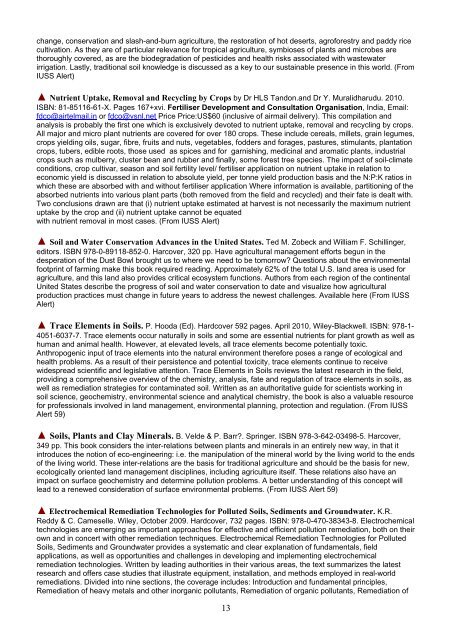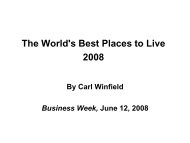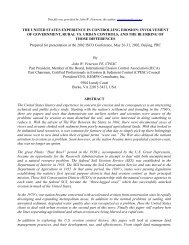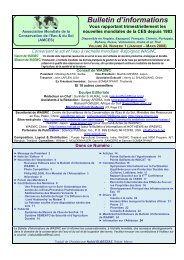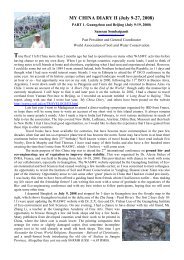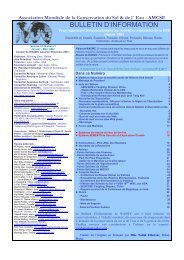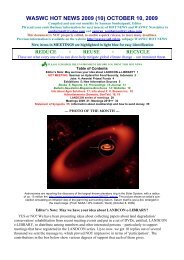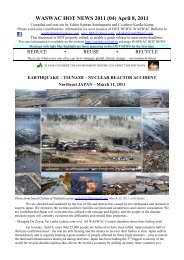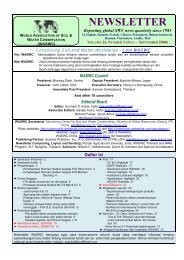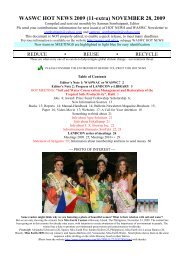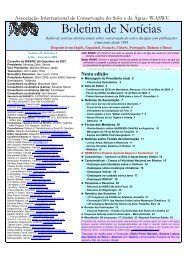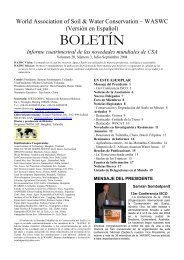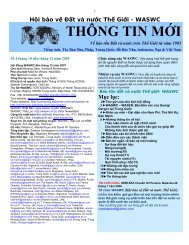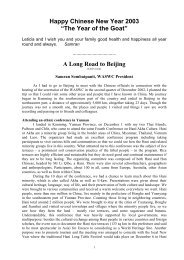April 30, 2010 - World Association of Soil and Water Conservation
April 30, 2010 - World Association of Soil and Water Conservation
April 30, 2010 - World Association of Soil and Water Conservation
Create successful ePaper yourself
Turn your PDF publications into a flip-book with our unique Google optimized e-Paper software.
change, conservation <strong>and</strong> slash-<strong>and</strong>-burn agriculture, the restoration <strong>of</strong> hot deserts, agr<strong>of</strong>orestry <strong>and</strong> paddy ricecultivation. As they are <strong>of</strong> particular relevance for tropical agriculture, symbioses <strong>of</strong> plants <strong>and</strong> microbes arethoroughly covered, as are the biodegradation <strong>of</strong> pesticides <strong>and</strong> health risks associated with wastewaterirrigation. Lastly, traditional soil knowledge is discussed as a key to our sustainable presence in this world. (FromIUSS Alert)▲Nutrient Uptake, Removal <strong>and</strong> Recycling by Crops by Dr HLS T<strong>and</strong>on.<strong>and</strong> Dr Y. Muralidharudu. <strong>2010</strong>.ISBN: 81-85116-61-X. Pages 167+xvi. Fertiliser Development <strong>and</strong> Consultation Organisation, India, Email:fdco@airtelmail.in or fdco@vsnl.net Price Price:US$60 (inclusive <strong>of</strong> airmail delivery). This compilation <strong>and</strong>analysis is probably the first one which is exclusively devoted to nutrient uptake, removal <strong>and</strong> recycling by crops.All major <strong>and</strong> micro plant nutrients are covered for over 180 crops. These include cereals, millets, grain legumes,crops yielding oils, sugar, fibre, fruits <strong>and</strong> nuts, vegetables, fodders <strong>and</strong> forages, pastures, stimulants, plantationcrops, tubers, edible roots, those used as spices <strong>and</strong> for garnishing, medicinal <strong>and</strong> aromatic plants, industrialcrops such as mulberry, cluster bean <strong>and</strong> rubber <strong>and</strong> finally, some forest tree species. The impact <strong>of</strong> soil-climateconditions, crop cultivar, season <strong>and</strong> soil fertility level/ fertiliser application on nutrient uptake in relation toeconomic yield is discussed in relation to absolute yield, per tonne yield production basis <strong>and</strong> the N:P:K ratios inwhich these are absorbed with <strong>and</strong> without fertiliser application Where information is available, partitioning <strong>of</strong> theabsorbed nutrients into various plant parts (both removed from the field <strong>and</strong> recycled) <strong>and</strong> their fate is dealt with.Two conclusions drawn are that (i) nutrient uptake estimated at harvest is not necessarily the maximum nutrientuptake by the crop <strong>and</strong> (ii) nutrient uptake cannot be equatedwith nutrient removal in most cases. (From IUSS Alert)▲<strong>Soil</strong> <strong>and</strong> <strong>Water</strong> <strong>Conservation</strong> Advances in the United States. Ted M. Zobeck <strong>and</strong> William F. Schillinger,editors. ISBN 978-0-89118-852-0. Harcover, 320 pp. Have agricultural management efforts begun in thedesperation <strong>of</strong> the Dust Bowl brought us to where we need to be tomorrow? Questions about the environmentalfootprint <strong>of</strong> farming make this book required reading. Approximately 62% <strong>of</strong> the total U.S. l<strong>and</strong> area is used foragriculture, <strong>and</strong> this l<strong>and</strong> also provides critical ecosystem functions. Authors from each region <strong>of</strong> the continentalUnited States describe the progress <strong>of</strong> soil <strong>and</strong> water conservation to date <strong>and</strong> visualize how agriculturalproduction practices must change in future years to address the newest challenges. Available here (From IUSSAlert)▲ Trace Elements in <strong>Soil</strong>s. P. Hooda (Ed). Hardcover 592 pages. <strong>April</strong> <strong>2010</strong>, Wiley-Blackwell. ISBN: 978-1-4051-6037-7. Trace elements occur naturally in soils <strong>and</strong> some are essential nutrients for plant growth as well ashuman <strong>and</strong> animal health. However, at elevated levels, all trace elements become potentially toxic.Anthropogenic input <strong>of</strong> trace elements into the natural environment therefore poses a range <strong>of</strong> ecological <strong>and</strong>health problems. As a result <strong>of</strong> their persistence <strong>and</strong> potential toxicity, trace elements continue to receivewidespread scientific <strong>and</strong> legislative attention. Trace Elements in <strong>Soil</strong>s reviews the latest research in the field,providing a comprehensive overview <strong>of</strong> the chemistry, analysis, fate <strong>and</strong> regulation <strong>of</strong> trace elements in soils, aswell as remediation strategies for contaminated soil. Written as an authoritative guide for scientists working insoil science, geochemistry, environmental science <strong>and</strong> analytical chemistry, the book is also a valuable resourcefor pr<strong>of</strong>essionals involved in l<strong>and</strong> management, environmental planning, protection <strong>and</strong> regulation. (From IUSSAlert 59)▲ <strong>Soil</strong>s, Plants <strong>and</strong> Clay Minerals. B. Velde & P. Barr?. Springer. ISBN 978-3-642-03498-5. Harcover,349 pp. This book considers the inter-relations between plants <strong>and</strong> minerals in an entirely new way, in that itintroduces the notion <strong>of</strong> eco-engineering: i.e. the manipulation <strong>of</strong> the mineral world by the living world to the ends<strong>of</strong> the living world. These inter-relations are the basis for traditional agriculture <strong>and</strong> should be the basis for new,ecologically oriented l<strong>and</strong> management disciplines, including agriculture itself. These relations also have animpact on surface geochemistry <strong>and</strong> determine pollution problems. A better underst<strong>and</strong>ing <strong>of</strong> this concept willlead to a renewed consideration <strong>of</strong> surface environmental problems. (From IUSS Alert 59)▲Electrochemical Remediation Technologies for Polluted <strong>Soil</strong>s, Sediments <strong>and</strong> Groundwater. K.R.Reddy & C. Cameselle. Wiley, October 2009. Hardcover, 732 pages. ISBN: 978-0-470-38343-8. Electrochemicaltechnologies are emerging as important approaches for effective <strong>and</strong> efficient pollution remediation, both on theirown <strong>and</strong> in concert with other remediation techniques. Electrochemical Remediation Technologies for Polluted<strong>Soil</strong>s, Sediments <strong>and</strong> Groundwater provides a systematic <strong>and</strong> clear explanation <strong>of</strong> fundamentals, fieldapplications, as well as opportunities <strong>and</strong> challenges in developing <strong>and</strong> implementing electrochemicalremediation technologies. Written by leading authorities in their various areas, the text summarizes the latestresearch <strong>and</strong> <strong>of</strong>fers case studies that illustrate equipment, installation, <strong>and</strong> methods employed in real-worldremediations. Divided into nine sections, the coverage includes: Introduction <strong>and</strong> fundamental principles,Remediation <strong>of</strong> heavy metals <strong>and</strong> other inorganic pollutants, Remediation <strong>of</strong> organic pollutants, Remediation<strong>of</strong>13


